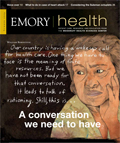Hannah's hope

Hannah Sames
Emory and organizations like Hannah's Hope are changing the research landscape through their consistent promotion of collaborative and coordinated research.
"Someone has to be the first to be cured."
Those are the words Matt Sames expressed to his wife, Lori, in the wake of their daughter Hannah's diagnosis with giant axonal neuropathy. Their daughter was just 4 years old at the time. Giant axonal neuropathy (GAN) is a rare genetic disorder that damages the nerve pathways that carry signals from the brain. The symptoms begin in the extremities: a dropped foot, awkward gait, tripping. Eventually victims have no ability to move, eat, or breathe. The disease is terminal in young adulthood.
It took 18 months for doctors to diagnose the uncommon disorder in Hannah. The first symptoms surfaced when she was 2 and family members noticed the arches on her feet rolled inward when she walked. Refusing to accept the lack of treatment options and minimal research being conducted on GAN, Matt and Lori Sames established Hannah's Hope, a public charity dedicated to funding research for a treatment and eventually a cure for GAN. "In our first seven months, we raised about $400,000 for research," says Lori Sames.
The latest recipient of a gift from Hannah's Hope is Emory University neurosurgeon Nicholas Boulis. Boulis, who also is a gene therapist, received $30,000 to bolster his research on neuro-gene therapy. His research focuses on finding the best way to deliver an altered gene to the nervous system of patients suffering from GAN. He is currently working to develop a surgical device to allow the delivery of spinal cord therapeutics including drugs, viral vectors, and stem cells. Boulis and his team are collaborating with virologist Jude Samulski and his team at the University of North Carolina's Gene Therapy Center to use preliminary data to apply for an NIH exploratory/developmental research grant.
Lori Sames says she knew she found the right researcher when Boulis told her he "gives a lot of credit to parents who refuse to take no for an answer." Sames has made refusing to accept "no" part of her mission since Hannah's diagnosis.
Indeed, Emory and organizations like Hannah's Hope are changing the research landscape through their consistent promotion of collaborative and coordinated research.
"Hannah's Hope is a parent-driven organization devoted to therapy development. We know exactly what causes GAN—mutations in a specific gene—and now we need a treatment," Sames says.
The timing seems to be right for giving Hannah hope.
"GAN involves a defect in the gene for gigaxonin, an important protein for maintaining the health of axons. We think this disease may provide insights that will guide the application of neuro-gene therapy to neurodegenerative disease," says Boulis. In other words, if Boulis and his colleagues can devise a treatment mechanism for GAN, they will take a major step in the treatment of other neurodegenerative diseases like amyotrophic lateral sclerosis (Lou Gehrig's disease) and Alzheimer's disease, which lack such a clearly defined genetic culprit.
In the meantime, Hannah and other children affected by GAN will continue to live their lives while they wait for a treatment. Hannah celebrates her 5th birthday this year. She will go to Chuck E. Cheese with her friends, and she's hoping her grandfather will get her the cell phone she has been wanting. And, while Hannah maintains the innocence so typical of a young child when it comes to her prognosis, her parents and Boulis know they need to move as quickly as possible if they are to save Hannah from the ravaging effects of GAN. Her central nervous system will be affected within the next 3 to 4 years.
"We could not let another family receive the news we did and hear that nothing could be done," Lori Sames says. "Our efforts will bring gene therapy to a new level, and Dr. Boulis is just the man to be on this mission with us. —Carrie Paine


